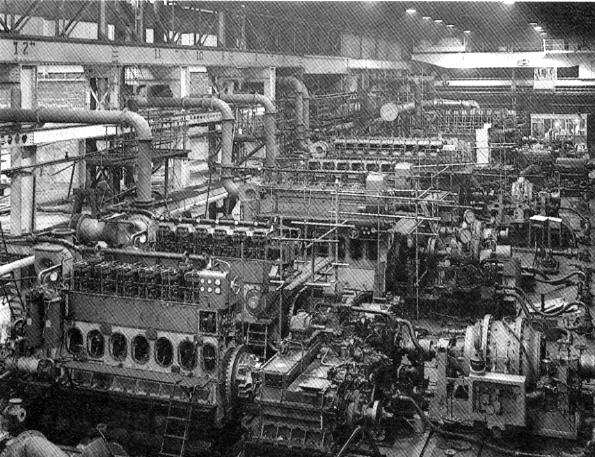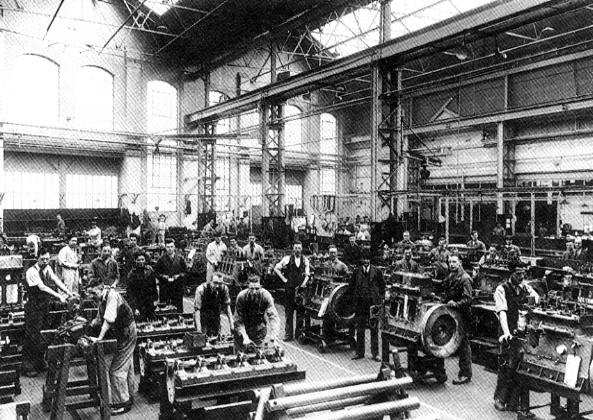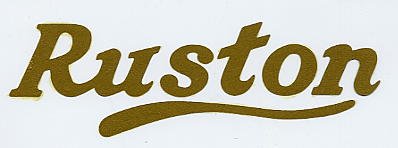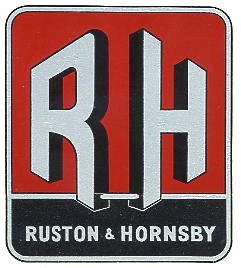Although a full range of steam engines was still being
produced at Lincoln, Rustons recognised that the internal combustion engine had
come to stay. Their horizontal engines were very successful, and they now
entered the field of large multi-cylinder vertical oil engines (see pictures
below) They were an immediate success in both industrial and marine
applications. Also in the early 1920's Rustons commenced building small
petrol/paraffin engines, which had a multitude of uses on farms, in factories,
on building sites etc. They were sold in tens of thousands, either as
independent engines or incorporated into packages such as lighting sets, pump
sets, compressors, mills, mixers etc. Many country houses that had previuously
relied on oil for their lighting could now boast electricity, provided very
cheaply by a small Ruston engine.

Ruston & Hornsby
large oil engine test bay c. 1940

Ruston & Hornsby small oil engine
erection shop c 1935
It was gradually becoming more clear that we had entered the age
of greater specialization. Ruston's range of products was too diverse, and they
decided to do something about it. A controlling share was purchased in the
Ipswich firm of Ransomes Simms & Jefferies, agricultural engineers. As part
of the agreement, Rustons transferred to them the manufacture of steam engines,
threshers, and the host of smaller agricultural implements. This move set
Ransomes on a new path to prosperity.
In another deal, they put money into the firms Barford & Perkins of
Peterborough, and Aveling & Porter of Rochester. A new company, Aveling
Barford Ltd., emerged. They moved to Grantham commencing production in part of
the old Hornsby factory. To help them, Rustons transferred their road roller
manufacture to the new company. They subsequently became world leaders in their
field.
Ruston Bucyrus Ltd
The excavator division was also on the move. The financing of new models
was becoming too expensive - Rustons sought amalgamation with American excavator
interests. The firm of Bucyrus Erie in South Milwaukee was looking for
expansion in the European market. They specialized in this field and were
building an attractive range of machines that were complementary to the Lincoln
products. The forces were joined and the new Company of Ruston Bucyrus Ltd., was
born on the 1st January 1930. The Lincoln factory was to benefit from the new
American designs, and Ruston engines were to be used throughout the R-B range.
The new company flourished.
Lister and the JP engines
Having shed most of their non-engine products, Rustons had concentrated
mainly on offering a wide range engines of all sizes and capabilities. There was
one obvious gap - the smaller vertical high-speed diesel. Listers were probably
the leaders in this field, but their engines were on the small side for Rustons.
The two companies got together and produced a joint engine, the 'JP'. Rustons
produced the larger components such as the crankcase, and Listers produced the
smaller elements. Rustons learned quickly, and very soon afterwards they were
producing high-speed diesels of wholly Ruston design. A wide range was made
available, and these engines became one of the company's main products.
Ruston Locomotives
In 1931, Rustons decided to re-enter the field of oil-engined locomotives.
The high-speed diesel was well established and the potential markets in mines
and quarries were very promising. Rustons promptly designed the first
successful underground oil loco. They solved the problems of of poisonous
exhaust fumes and the danger of fire from sparks igniting gases. They
subsequently became one of the World's largest producers of narrow-gauge
locomotives. Soon after they produced an impressive range of standard gauge
shunters.
World War II
The Second World War brought fresh demands on Rustons. Their engines were
ordered for a great variety of of specialised wartime equipment. Flameproof
loco's were required in great numbers for use in ammunition depots. Ruston
engines powered fleets of minesweepers, landing craft, patrol boats, midget
submarines, etc. They also provided auxilary power on the larger Naval ships.
One of the Ruston factories was equipped for the production of tanks. The
first model built was the Matilda - 400 were built. Next came the Cavalier, 220
being produced. Another type was the Crusader. Its design was not sufficiently
advanced so Ruston converted it into a Bren Gun carrier and prduced 600 of them.
Stationary engines were used in every field of operations. generating sets
provided power for lighting, heating, refrigerating, ventilating etc. They were
incorporated into pumping sets, compressor sets, winching sets etc. The total
output for the war effort was tremendous. Although the post-war years brought
full order books, competition from Japan and the USA became very fierce and
profit margins became much slimmer. The products were becoming more
sophisticated, and costs of new designs were major factors. Even so, Rustons
found the money, and the skills, to commence one of their most ambitious
products ever, the gas turbine.
To be continued. © European Gas Turbines Ltd 1997
• Main •
History menu
•




